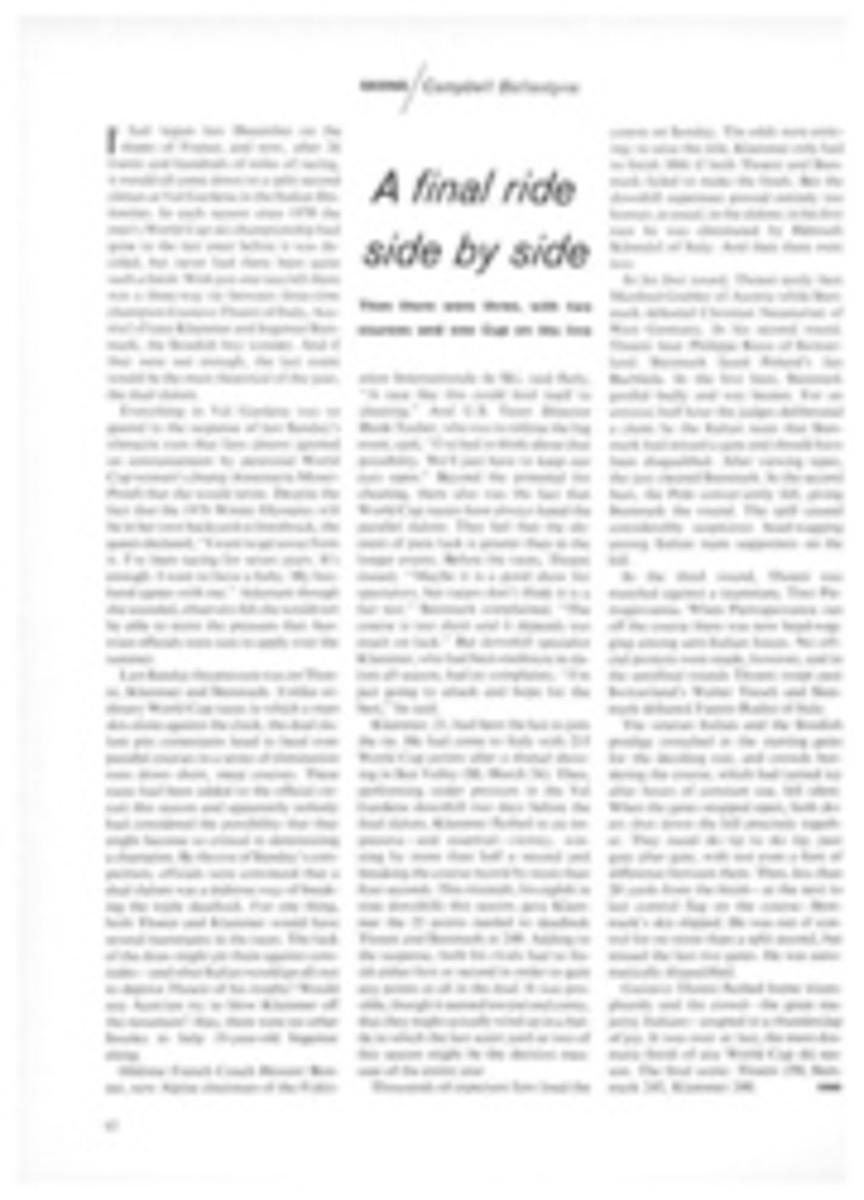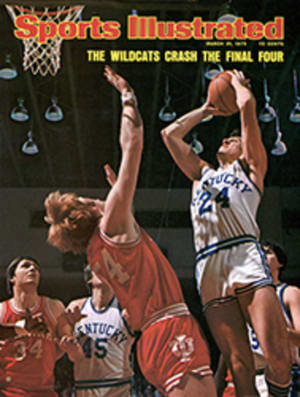
SCORECARD
THE GAMES PEOPLE DON'T PLAY
There has been no official announcement, but when the chairman of the Davis Cup Committee of Management says such things as, "We can't allow the competition to be disrupted" and "The Committee...has to take some action," one hardly need glance at the fluttering national flags to know which way the wind blows. Mexico has defaulted its scheduled match with South Africa, the current Davis Cup champion, Colombia has announced its intention of defaulting and Chile could follow suit. Four years ago, when a number of other nations threatened to withdraw from competition rather than compete against South Africa, South Africa was barred. It makes sense. Consider, for instance, the advantages of not playing the Oakland A's. Out they would go, and at long last baseball would have a new world champion.
SLAUGHTERHOUSE NINE
The rambling wreckers from Georgia Tech have been at it again. It was just 59 years ago this fall that they thumped Cumberland 222-0 in college football's most lopsided game. Last week, after softening up little Earlham College of Richmond, Ind. 22-7 in a Thursday baseball game, the next day they dropped the nutcracker on the Hustlin' Quakers 41-0.
Oddly, the score was respectable through the first three innings. Although Tech's Jerry Bass was pitching a no-hitter—he finished it, striking out 19—and Earlham was booting the ball around as though the game were soccer, the score was only 5-0. Then the roof fell in. Tech scored three runs in the fourth, eight in the fifth, 11 in the sixth, four in the seventh and 10 in the eighth. Mercifully, the host Yellow Jackets did not have to bat in the ninth.
The Hustlin' Quakers contributed to their dismemberment with 13 errors, 15 bases on balls, and one wild pitch. Tech had only 28 hits (including seven doubles and three home runs), which was just fine by Coach Jim Luck, who spent most of the game trying to figure a way to keep down the score. A football assistant in the fall, he knows what you do in that game—punt on first down. Never did find the baseball equivalent, though.
THE HOUSE THAT TRUTH BUILT
Close observers of stadium construction will be shocked by what is happening outside of Detroit. Pontiac Metropolitan Stadium, roof and all, is being brought in on time and almost exactly on cost.
Contracts were signed two years ago and work began in October 1973. The architects and builders, local people who never tried a stadium before but who studied plenty of them before undertaking this project, are guaranteeing they will be ready for the opening event, an exhibition football game between the Kansas City Chiefs and the Detroit Lions on Aug. 23.
The stadium has the usual accouterments of modern arenas—electronic scoreboard, contour seats, private suites, dining club, massive parking lots fed and emptied by superhighways—but, in several instances, with a difference. The suites are on the middle deck and are closer to the field than in most other stadiums. So is the dining room, which affords customers a broad view of the field through a 250-foot-long, two-story-high glass wall. A railroad line passes next to the stadium and could, if necessary, become the main transportation to and from the park.
Pontiac will hold 80,400 and, with a majority of its seats along the sidelines in three tiers (no columns), is ideal for football though hopeless for baseball. The sidelines and end lines are only 40 feet from the nearest seats, which are raised seven feet above the field. The roof, if it holds up, is something every future arena builder should look into. It is made of woven fiber-glass fabric coated with Teflon and is supported by a latticework of steel cables and a system of blowers, up to 29 working during games and, say, rock concerts—many of which have been scheduled. Two blowers operate when the facility is idle. The design was used first for the American pavilion at Expo '70 in Osaka and more recently for a smaller stadium in Santa Clara, Calif. The roof is comparatively cheap to install.
Claims by Pontiac boosters that "computer-calculated" sight lines assure unobstructed views for everyone and that a lightning-fast food service will feed 5,000 people a minute we will believe after we have sat behind an Afro or bouffant and downed one of those instant hot dogs.
But the cost is believable and beautiful: $55.7 million, a mere pittance by New Orleans standards. It is being paid by bond issues of two years ago, the interest from which has helped to offset inflation—that and some judicious paring of luxuries. It will be no Superdome but, come to think of it, so far neither is the Superdome.
NO IFS, ANDS OR BUTTS
Joe Stanton, administrator of Maryland's Port Authority, has returned from his vacation in Naples, Fla. with an arm in a sling, and we might as well get to the seat of his problems right away.
They started on the Gleves golf course when Stanton stepped from his cart to play a shot, He took a drag from his cigarette and placed it in an ashtray in the cart. As he addressed the ball a gust of wind blew the cigarette onto the cart's unoccupied driver's seat. Joe's wife Vicki meanwhile had played her shot. She returned to the cart and sat down—on the lighted cigarette.
Somewhat startled, to say the least, she put on about five quick moves, one of which started the cart. It surged forward over Joe, breaking his arm. That hurt, but the real pain came when his brother John, who was playing in the same threesome, bent over him. "Joe," he said, "that will be a two-stroke penalty for delaying play."
TOP HAT
The seven-foot high jump is now so old hat that when Alphonso Irving of William and Mary cleared 7'1" in the NCAA indoor championships, he didn't take his off.
STEADY AS SHE GOES
During the Great Depression sport suffered less, financially, than most businesses. Except for college basketball, which was off 5%—possibly because games were televised regularly on weekends for the first time—sport was not doing badly in 1974, either.
Horse racing, aided by 400 additional racing days, drew 1.5 million more fans and continued to lead all sports in attendance with 48,823,814 spectators. Directly behind and 1.5 million healthier, too, was auto racing, followed by college football and major league baseball, both off by a few thousands. The only real casualties were pro football which, beset by strikes, extensive televising and no-shows, was down by half a million, and baseball's 18 minor leagues, down 216,000. These were more than offset by the steady increase in the number of pro and college hockey fans, quantum leaps for boxing, wrestling, soccer and tennis and ("Here Comes Rusty!") greyhound racing, which attracted 16.3 million. That meant 1.2 million more people went to the dogs last year than in '73, 6.2 million more than a decade ago. Rusty, the mechanical rabbit, has developed quite a following.
YER OUT!
After several questionable calls in the second game of a doubleheader last week, Pan American baseball Coach Al Ogle-tree could stand the embarrassment no longer. The visiting University of Nebraska at Omaha team clearly had been victimized. Ogletree called time, walked onto the field and fired one of two infield umpires on the spot. All right, let's hear it for Al Ogletree!
EXOTIC BETTORS
In the two decades she has served as the Florence Nightingale of the railbirds at Pimlico, Nurse Imogene Hicks has seen a little of everything. There was, for example, the patron with a heart condition who used to take up his station outside the first-aid room and down liberal doses of medicine between races. "I'd rather die here than at home," he told Miss Hicks, "because I'd die happy."
But her alltime favorite is a horse-player who arrived on a stretcher showing no signs of life—no blood pressure, no pulse. The staff was about to pull a cover over his head when the results of the latest race began to come over the PA system. The cadaver sat bolt upright on the stretcher and asked, "Who won?" "We told him," says Nurse Hicks, "and he got up and walked straight out." They never knew where he went but they were fairly sure it wasn't to the Great Cashier's Window in the sky.
SURVIVAL COURSE
Jack Christiansen, the old pro who now coaches football at Stanford University and considers himself a harsh realist, had bad news last week for the minor college sports and even major ones like swimming, track and baseball. "Don't get me wrong," he said. "I'm not advocating the dropping of the minor sports. But when the time comes to start checking the spiraling costs of college athletics—and that time is really now—then you can look for the nonrevenue-producing sports to suffer most.... Those who can pay their way will survive. That's the way it has always been, hasn't it?"
Well, no. There are still a lot of schools in the country that consider athletics an integral part of the college experience and accept it as a fact of academic life that they will lose money. MIT, for one, fields, boats and courts 32 different teams—not including football—with no hope of realizing a profit from any of them.
But this is a vast subject that the NCAA will come to grips with in a special meeting set for April 24-25. And the American Council on Education, which represents 1,565 colleges and universities, is trying to put together a blue-ribbon commission to investigate "the whole series of questions relating to intercollegiate athletic programs," says Dr. John W. Oswald, president of Penn State and until recently president of ACE.
Christiansen says that Stanford last year had 120 football players on scholarship, each at $5,500 a year. He will be interested in some figures developed by the Oakland Financial Group, Inc. of Charlottesville, Va. Four years at a public college, the fund predicts, will cost $56,160 in 1993. The cost at a private college will be $98,280. At prices like that big-time football might be the first sport not to survive. The NCAA and ACE are acting just in time.
TABPSSLCPOOASSB
Sure enough, what Ohio broadcasters were dreading most finally happened. Mississinawa Valley met Gnadenhutten Indian Valley South in the semifinals of the state's Class A high school basketball tournament.
WEARIN' THIN OF THE GREEN
Since it was St. Patrick's day, the theme at the Tony Lema Memorial Pro Am at Marco Island, Fla. was Irish. There was green beer, Gene Sarazen in green knickers, foursomes singing Irish ditties, Ara Parseghian, shillelaghs, thick brogues, Jackie Gleason and a sentimental favorite, Buddy Allin. The thin, freckle-faced pro with a shock of red hair not only looks like a leprechaun, his clubs are manufactured by Shamrock. Alas, a great day for the Irish it was not to be. First, an Irish setter interrupted play. A covey of winded marshals finally nailed him and roped him to a tree. Then, Allin failed to turn in a score. Said he had no luck.
ILLUSTRATION
WARNING: IT IS DETERMINDED THAT CIGARETTE SMOKING IS DANGEROUS TO YOUR HEALTH
THEY SAID IT
•Ron Dose, Sioux City, Iowa policeman, after separating Sioux City and Waterloo brawlers in a United States Hockey League game: "It hurts when they step on your feet with those skates."
•Paul Cameron, Little Falls, Minn. high school star, asked what he was doing on a team that included Frank Wachlarowicz, Steve Bzdok, Jerry Januschka and Bruce Posch: "Oh, coach calls me Cameronski."
•Al Braverman, fight manager, reacting to a suggestion that Muhammad Ali might complain about his using a "foreign substance" on Chuck Wepner's face: "It's not a foreign substance. It comes from the United States."

